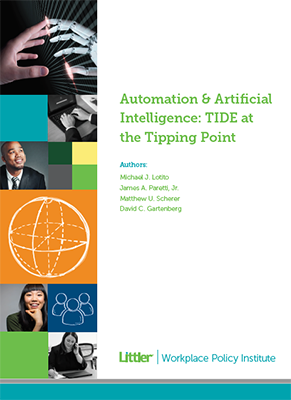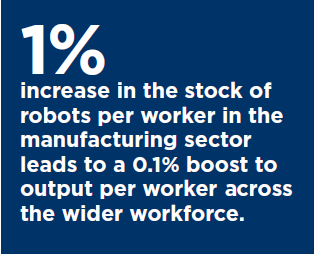
COVID Accelerates Automation & Job Losses
Is it time for a new-age G.I. Bill that targets reskilling/upskilling?
it may also reveal an America similarly unprepared to deal with a pandemic of the displaced and jobless.”
The one-two punch: virus and recession
In the past four weeks, 22 million jobless claims have been filed. Still unaccounted for, yet needing to be added to the behemoth jobless list, are another four million gig workers and temporary employees. That’s 26 million jobless, or 20 percent of 130 million-person U.S. workforce, according to Joseph Brusuelas, chief economist at audit firm RSM.
Quite possibly in another four weeks, even amid frequent COVID fire fights, many of the 26 million will begin trickling back to work; but it won’t be business as usual.
“Put simply,” warns the Brookings Institute, “any coronavirus-related recession is likely to bring about a spike in labor-replacing automation.” “Labor-replacing automation” means, of course, workers out of a job.
Red flags are beginning to be raised everywhere. Vox and Bloomberg have already broken with disquieting headlines: The Coronavirus Recession Is Already Here; and U.S. Recession Model at 100% Confirms Downturn Is Already Here.
Dalia Marin, Chair of International Economics at the University of Munich and a research fellow at the Center for Economic Policy Research, is out with How COVID-19 Is Transforming Manufacturing. She points out that during the Great Recession, “the sharp post-2008 decline in interest rates relative to wages, boosted robot adoption and reshored a larger share of production;…so far, a 30 percent drop in interest rates can be expected [2020], as central banks try to offset the damage of the COVID-19 pandemic. Past data indicate that this could bring a 75.7 percent acceleration in robot adoption.”
75 percent!
Aftermath
Analysts, labor experts, government officials, and petabytes of research data are forecasting the waves of returning workers will crash headlong into a mega-wave surge in workplace automation.

The net-net will be millions back to their workplaces trying to make their familiar jobs feel familiar once again, while millions of others will return to their former employers as full-time employees, but only temporarily, while still others won’t return at all.
Needless to say, there are 22 million jobless and self-isolating U.S. citizens, who, with good reason, are future-jittery. People, who not only are faced with onerous financial obligations, but who have also taken a major hit to their sense of self-worth, as Aliya Hamid Rao examines in her recent Harvard Business Review piece: When Losing Your Job Feels Like Losing Your Self.
COVID has accelerated an otherwise rapid disruption of the American workplace, especially in manufacturing, with automation processes that will have a profoundly adverse effect on decades of comfortable, middle-class-building, full-time jobs.
To make matters worse, the U.S. government admits it’s “unable to quantify automation’s effect on the workforce”. The Government Accountability Office (GAO) is clueless, as the title of this disturbing GAO report confesses: WORKFORCE AUTOMATION: Better Data Needed to Assess and Plan for Effects of Advanced Technologies on Jobs
Feds Clueless About Impact of Automation
After six years of media frenzy and taxpayer concern over automation, still no action…or even a plan.
COVID reveals…
The U.S. may soon find out that just as COVID revealed an American healthcare system unprepared to deal with a pandemic, it may also reveal an America similarly unprepared to deal with a pandemic of the displaced and jobless.
In the aftermath of the post-2008 Great Recession, 6 million workers slipped beneath the waves of permanent unemployment. They’ve been seldom heard from or even thought about since. That kind of neglect won’t do this time around.
This time, the numbers of jobless will be way too large to overlook or ignore. In response, should the federal government take action and pony up $2 trillion (as it has for both unemployment benefits and business) to reskill the country’s shaken breadwinners for a new future?
Certainly, without them, there is no future. So, why wait until the GAO is sure of itself or mass unemployment becomes debilitatingly chronic?
With COVID and the unprepared healthcare system, the nation set sail and is triaging the country as it goes along. Not the best of scenarios, but we’re in it and we’re making progress. Should the nation do the same with the future of work? Time is of essence.
Worker Reskilling Act of 2020
In 1944, the U.S. was faced with what to do with 16 million returning service men and women after the war. Certainly, no one wanted a repeat of the chaos and tragedy of returning veterans post-World War One. Barely two weeks after D-Day, President Franklin Roosevelt, on June 22, 1944, signed into law the Servicemen’s Readjustment Act, which came to be known as the G.I. Bill.

“The effect of the G.I. Bill was multigenerational – it improved the lives not only of returning soldiers, but of their children and grandchildren as well,” wrote Jeff Nilsson, in his eye-opening How the G.I. Bill Changed America.
“It provided veterans help in buying a home, setting up their own business, starting a farm, going to college, learning a trade, finishing high school, or getting a government job.”
Okay, that’s nice help with the dishes, but here is the key part that bears on reskilling America post-COVID: “The G.I. Bill would pay for up to four years of veterans’ college tuition, text books, career counseling, and a living allowance.”
So, what did Americans do with this unusual opportunity? Squander it? Here’s a reply from the author:
“The millions of veterans who took advantage of a free college education helped raise the productivity of the American work force and bring it into the space age. They provided the technical expertise that revolutionized electronics, computers, aeronautics, media, and business management. They also found employment on major new government projects, like the interstate highway system and the space program.
“The education benefits also helped some veterans to make outstanding contributions to American society. These included 14 Nobel prize winners, three Supreme Court justices, three presidents, a dozen senators, and 24 winners of the Pulitzer Prize.”
All of those millions of nervous living rooms across the country might really take to a G.I. Bill the same way veterans did in the ‘40s. Just maybe a Worker Reskilling Act for 2020 could revitalize spirits that sorely need something uplifting right about now.
It’s also valuable to remember that those aforementioned living rooms are also filled with voters, and there’s an important election that they could easily sway upcoming this November.
See related:
Pink Slips for Old Technology
Studs Terkel, Robots & Our Jobs
Technology reaps…and sows, and we need to be ready faster for both!
What’s Going to Happen to Us?
Confronting fear with training
Here’s How It’s All Going Down
By now, everyone, unless you’ve been under a rock, is aware that automation, robots, artificial intelligence, and 3D printing are remaking workplaces, especially those in manufacturing and logistics, but also in offices and other business workplaces.
It’s happening everywhere, but mainly concentrated in what are called the advanced-economy countries or AECs (foremost are the U.S., Germany, Japan, Korea, and China).
Most everyone, in AECs or otherwise, is worried about automation taking jobs from people. Simply put, automation is indeed doing just that—taking jobs. And the COVID pandemic is piling on, exacerbating the process by hurrying automation along. In short, because of COVID, people are losing jobs to automation at a faster clip, which may get even faster very soon.
However, the same COVID pandemic is also presenting governments and people with a chance to confront all of their automation fears and to turn them into a huge positive for humankind and for generations to come.
The opportunity to reskill/upskill millions of workers is happening right now. COVID has created a national emergency. A war, as it’s being tabbed by many. This is reskilling’s best chance to go viral in a hurry.
The model for such a recovery, a G.I. Bill-type national effort for workers, has been tried with great success with military veterans for over 75 years.
What’s automation going to do to us?
A trio of researchers from the Brookings Institute is out with a paper titled The Robots Are Ready As the COVID-19 Recession Spreads. It’s a well-researched and commonsense scenario of how automation is now taking over, and will continue to take over, workplaces and jobs.
 Here’s how the trio sees what’s happening. “Robots’ infiltration of the workforce doesn’t occur at a steady, gradual pace. Instead, automation happens in bursts, concentrated especially in bad times such as in the wake of economic shocks, when humans become relatively more expensive as firms’ revenues rapidly decline.
Here’s how the trio sees what’s happening. “Robots’ infiltration of the workforce doesn’t occur at a steady, gradual pace. Instead, automation happens in bursts, concentrated especially in bad times such as in the wake of economic shocks, when humans become relatively more expensive as firms’ revenues rapidly decline.
At these moments, employers shed less-skilled workers and replace them with technology and higher-skilled workers, which increases labor productivity as a recession tapers off.
As Dalia Marin, from the Center for Economic Policy Research, says about this shedding of workers: “The arithmetic is simple. A company in, say, the United States would have to pay an American worker a lot more than, say, a Vietnamese or Bangladeshi one. But a US-based robot would not demand wages at all, let alone benefits like health insurance or sick leave.”
Long story short, be a chunk of technology or a skilled worker to be safe. If not, reskilling is in order. As Eldridge Cleaver used to say: “You either have to be part of the solution, or you’re going to be part of the problem.”
Nir Jaimovich and Henry E. Siu, in a paper Job Polarization and Jobless Recoveries, for the National Bureau of Economic Research, report that highly “automatable” jobs accounted for 88 percent of the job losses from the three recessions over the last 30 years.
The Brookings’ trio then flagged 20 industry categories with “some 36 million jobs that have a ‘high’ susceptibility to automation,” especially during crises.
Probably not all 36 million jobs at once, but over time—a relatively short time, all “automatable” jobs are going to go to machines.
Priority reskilling/upskilling occupations would then be the 20 flagged industry categories (see Brookings chart)
Brad Hershbein and Lisa Kahn, for their paper in the American Economic Review, looked for the most vulnerable jobs from almost 100 million online job postings before and after the Great Recession. Hardest-hit occupations were the automatable “routine” tasks where “unskilled” workers were steadily replaced with a mix of technology and skilled workers.
Again, routine tasks are automatable, and therefore the future for machines, not a future for humans.
In the past, the unfortunate automated out of their jobs were tossed upon the government unemployment rolls for seven or eight months, until their eligibility was exhausted, and then they were basically jettisoned.
What happened next to them was a greater tragedy than joblessness: millions of capable contributors to the country’s well-being and future were forever lost. Most idled in the Great Recession have dropped out of job-hunting years ago. Six million of the discouraged and jobless no longer participate in looking for employment. Had they skills, a far different outcome might have been their fate.
A new-age G.I. Bill for 2020 could save most anyone in jeopardy of job loss…if we move fast enough. Right now, everyone is literally at home waiting; it’s a perfect time to connect with them.
See related:
Robot Fatigue, Reskilling & Jobs
Workers and employers alike have robot fatigue; they have turned the page, and with clearer heads, are now preparing for a possible bright new future.
The End of the Great Robot Scare
Is it a lull or true change? Something new is in the air…and it’s been a long time coming.






